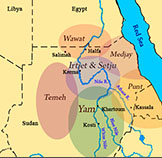HistoryEarly Statehood in SudanThe kingdom of Kush, centered at Kerma, has been the most dominant entity in the early history of Sudan. However, evidence indicates that Kush was not the only state in the region. Other smaller polities have coexisted with the Kushite kingdom. The earliest evidence of these polities comes from the inscriptions of Harkhuf, who served as the Egyptian governor of Upper Egypt during the Old Kingdom. The inscriptions, found on his tomb, tell of an explorative expedition that he undertook deep into Sudan.
Through his account, Harkhuf provides us with invaluable indications, though somewhat vague, on the early developments, political structuring, and formation of statehood in Sudan. Nonetheless, the account is shaped by three major problems. First, geographical locations are vaguely described. Second, no satisfactory explanations of the political structures of the mentioned polities are provided. Third, the account is written from a perspective that is biased towards Egypt. Being Egyptian, Harkhuf was inclined to present the people of Nubia as weak. The account mentions five regional entities in Sudan: Wawat, Irtjet, Setju, Yam, and Temeh. Each polity was evidently headed by a ruler. Out of the five, Yam is Harkhuf's major concern. He describes Yam as the most dominant: "Now when the chief of Irthet [Irjet], Sethu [Setju], and Wawat saw how strong and numerous was the troop of Yam...".1 According to his account, Yam has not only established itself as the strongest state in Sudan but was rapidly expanding in territory. Regarding the political structure of Yam, Harkhuf makes it clear that the state was ruled by a single person, or a king. He also makes it clear that Egypt was threatened by Yam’s imperial expansion. Although the precise geographical location of Yam is not provided by Harkhuf, the products associated with the state must have come from the sub-Sahara. Products, such as ivory and ebony, brought by Harkhuf from Yam, must have come from regions much to the south of Kerma. Also the pygmy features of the boy brought by Harkhuf, which are typical of populations from Equatorial Africa, are not found among the people of Kush.2 Because of such indications, some scholars are inclined to suggest that Yam was located much to the south of Kerma; that is in the Meroe-to-Khartoum area. 3This places the sub-Sahara in a much closer geographical proximity to Yam. Wawat, on the other hand, referred to Lower Nubia, between the First and Second Cataracts. While Irtjet and Setju were both located in Upper Nubia, south of Wawat and north of Yam, we are unaware of their precise locations. Harkhuf's account indicates that the three polities—Irjet, Setju, and Wawat—were at some point combined into a single large polity. Accordingly, Irjet and Setju would have constituted the kingdom of Kush centered at Kerma. Wawat, on the other hand, would have been absorbed by Kush; this suggestion is supported by the northerly territorial expansion of the Kushite kingdom during the First Intermediate Period4. Temeh, was an independent polity that flourished in the Libyan Desert, in modern Sudan's State of Kordofan. The people of Temeh are identified as Libyans, though they have always been mentioned in Egyptian records as being closely related to the people of Nubia. Records of Harkhuf 's third journey to Sudan, speak about the military expedition by the king of Yam"... to the land of Temeh to smite Temeh as far as the western corner of heaven."5 The Medjay and Punites formed the two earliest known organized populations in eastern Sudan. The most recent and significant sources on land of Punt date to the fifteenth century BC. By comparison, the Medjay, known today as the Beja, continued to dominate eastern Sudan until contemporary times.
Edited: Jan 2009. |
